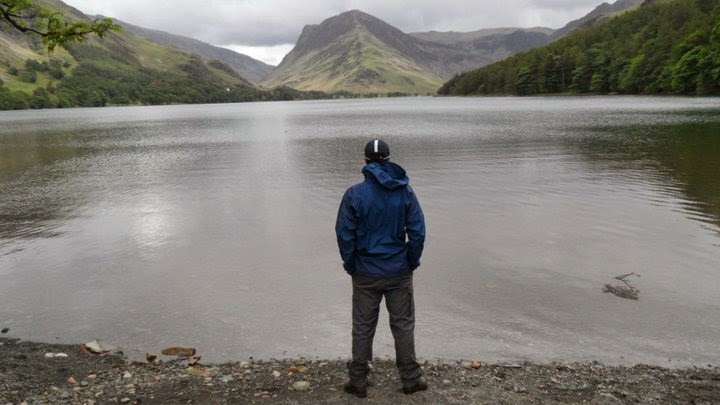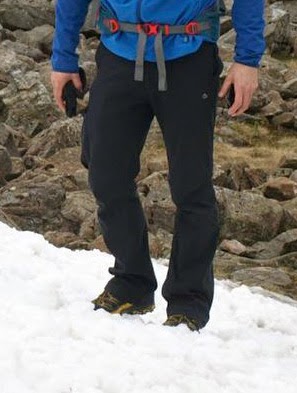Basically it's a layer without sleeves. It gives (usually) a measure of insulation but without the puffiness around the arms that you may get with other layers, especially those that use the same level of fill across the whole item.
It's quick and easy to put on and light to pack down in the bag. They're usually not so puffy that they make you feel like the Michelin Man but just give that added extra layer of warmth you may want, whether it be on stops or around camp.
Of course there are different types of fill (down or synthetic), different levels of fill (whether it be 60, 100 etc) or and different types of fill (goose down or duck down, Primaloft One, Primaloft Eco or an own brand fill etc).
Enter the Berghaus Ignite Vest. Now this is just a helpful review simply from one I ordered but had to return (due to a fault which probably came as a result of its delivery). So this has not been tested in the field, unlike most of my gear which has travelled about a fair bit. So that's my 'caveat emptor' !
 |
| Out in the 'wilds'... medium Berghaus Ignite Vest over medium OR Ferrosi hoody |
 |
| Aerial view of the front of the Berghaus Ignite Vest |
I am 5'11" and an athletic medium build (just over 10 stone). I'm wearing a medium OR Ferrosi hoody underneath to vest, just to give some help, as I hate reviews that say "this fitted me fine" but fail to mention their height, their build or the size of the top etc! Aaagh!
The weight of the Ignite Vest is about 250g according to one listing I found on ebay. This seems about right considering the weights of other similar tops.
The Berghaus Spec I've gleaned from various sites as for some unknown reason, Berghaus refuse to put the full information on their website for products, despite having been
PRIMALOFT ONE insulation
PERTEX Outer shell
Exposed reversed coil front zip
Two zipped hand warmer pockets
Technical fit
Size: L
MATERIAL: PERTEX Microlight
WEIGHT: 250 g
FILL: 60
The fit of the top as I've mentioned is just about right. If you have any padding or want to over layer the smock on other thickish items you'd probably best go up a size. The medium is just about right - it's not fitted but is on the slightly snug side (certainly compared to the 'medium' Ferrosi hoody with its extra American sizing!) I didn't find the top getting in the way when moving my arms around much so it's not a restrictive fit, at least not for me.
Unlike some tops which seem to delight in mass branding across their clothing like you're some piece of cattle in a mass Coloradon branding project, the back of the Ignite Vest is plain black. Nice.
The top as you'll see has a main strong zip down the front and two zipped pockets which is I think perfect for a vest / gilet. There is a 'beard guard' to some extent under the chin and a a zip guard behind the zip to avoid snagging when doing up the zip.
 |
| Berghaus Ignite Vest showing the collar |
The top of the vest has a collar which can get in the face a touch but is actually very soft and doesn't get in the way, at least not when briefly testing the top. it will provide a lovely snug fit in colder temperatures!
 |
| Showing the drop tail and hem drawcords of the Berghaus Ignite Vest |
So the feel of the fill. Well here we are on a June Summer's day where the temperature has dropped to 18C from a mini heatwave and the monsoon rains are arriving.... Perhaps not an ideal time to be buying, let alone using a Primaloft insulation layer. However, in my brief 2 day 'testing' (if that's what you can call it) saw me feel perfectly comfortable with the Ignite Vest on. So I'd say it may be breathable but not sure that it would add a great amount of warmth.
The outer surface of the Ignite Vest is Pertex Microlight (ripstop). With any lightweight fabric, the payoff is durability. I certainly wouldn't want to wear the Ignite Vest under an abrasive pack or for use when scrambling too much etc (despite microlight being stronger than pertex quantum). The reason I had to return my vest was because of a tug that was there when I got the jacket. This had actually cut into the fabric. Of course for considerable extra (£25-£40) cost, things like the Arcteryx LT Atom Vest or the Paramo Torres Vest have a stronger face fabric.
 |
| Macro shot of the rip in the vest (1cm from top left to bottom right). Ripstop doing its job! |
Of course a 60g level of insulation isn't huge but I think it would be excellent for Spring-Autumn use and as an extra layer in Winter. The great thing with a vest is that you can pack it into your bag and hardly know it's there. If I were wanting something for winter I'd certainly be looking at something like the Rab Generator Vest which has a 100 fill of Primaloft One (or a jacket with more fill). But the great thing about the Ignite Vest is that you'd hardly know it was there. Extra warmth, lightweight, breathable, just £54 (what I paid) and hardly noticeable - what's not to like!
Oh and this is the best looking gilet / vest I've seen... If that makes any difference to you!













































